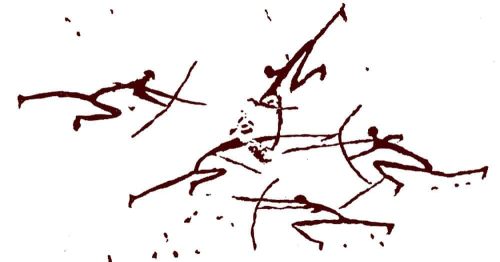Publication
Archaeological evidence suggests that the population dynamics of Mid-Holocene (Late Mesolithic to Initial Bronze Age, ca. 7000–3000 BCE) Europe are characterized by recurrent booms and busts of regional settlement and occupation density. These boom-bust patterns are documented in the temporal distribution of 14C dates and in archaeological settlement data from regional studies.
We test two competing hypotheses attempting to explain these dynamics: climate forcing and social dynamics leading to inter-group conflict. Using the framework of spatially-explicit agent-based models, we translated these hypotheses into a suite of explicit computational models, derived quantitative predictions for population fluctuations, and compared these predictions to data.
We demonstrate that climate variation during the European Mid-Holocene is unable to explain the quantitative features (average periodicities and amplitudes) of observed boom-bust dynamics.
In contrast, scenarios with social dynamics encompassing density-dependent conflict produce population patterns with time scales and amplitudes similar to those observed in the data.
These results suggest that social processes, including violent conflict, played a crucial role in the shaping of population dynamics of European Mid-Holocene societies.
D. Kondor, J.S. Bennett, D. Gronenborn, N. Antunes, D. Hoyer, P. Turchin, Explaining population booms and busts in Mid-Holocene Europe, Scientific Reports 13 (2023) 9310.
Related

Signup
| Cookie | Duration | Description |
|---|---|---|
| cookielawinfo-checkbox-analytics | 1 year | Set by the GDPR Cookie Consent plugin, this cookie records the user consent for the cookies in the "Analytics" category. |
| cookielawinfo-checkbox-functional | 1 year | The GDPR Cookie Consent plugin sets the cookie to record the user consent for the cookies in the category "Functional". |
| cookielawinfo-checkbox-necessary | 1 year | Set by the GDPR Cookie Consent plugin, this cookie records the user consent for the cookies in the "Necessary" category. |
| CookieLawInfoConsent | 1 year | CookieYes sets this cookie to record the default button state of the corresponding category and the status of CCPA. It works only in coordination with the primary cookie. |
| PHPSESSID | session | This cookie is native to PHP applications. The cookie stores and identifies a user's unique session ID to manage user sessions on the website. The cookie is a session cookie and will be deleted when all the browser windows are closed. |
| viewed_cookie_policy | 1 year | The GDPR Cookie Consent plugin sets the cookie to store whether or not the user has consented to use cookies. It does not store any personal data. |
| Cookie | Duration | Description |
|---|---|---|
| mec_cart | 1 month | Provides functionality for our ticket shop |
| VISITOR_INFO1_LIVE | 6 months | YouTube sets this cookie to measure bandwidth, determining whether the user gets the new or old player interface. |
| VISITOR_PRIVACY_METADATA | 6 months | YouTube sets this cookie to store the user's cookie consent state for the current domain. |
| YSC | session | Youtube sets this cookie to track the views of embedded videos on Youtube pages. |
| yt-remote-connected-devices | never | YouTube sets this cookie to store the user's video preferences using embedded YouTube videos. |
| yt-remote-device-id | never | YouTube sets this cookie to store the user's video preferences using embedded YouTube videos. |
| yt.innertube::nextId | never | YouTube sets this cookie to register a unique ID to store data on what videos from YouTube the user has seen. |
| yt.innertube::requests | never | YouTube sets this cookie to register a unique ID to store data on what videos from YouTube the user has seen. |
| Cookie | Duration | Description |
|---|---|---|
| _ga | 1 year | Google Analytics sets this cookie to calculate visitor, session and campaign data and track site usage for the site's analytics report. The cookie stores information anonymously and assigns a randomly generated number to recognise unique visitors. |
| _ga_* | 1 year | Google Analytics sets this cookie to store and count page views. |
| _gat_gtag_UA_* | 1 min | Google Analytics sets this cookie to store a unique user ID. |
| _gid | 1 day | Google Analytics sets this cookie to store information on how visitors use a website while also creating an analytics report of the website's performance. Some of the collected data includes the number of visitors, their source, and the pages they visit anonymously. |